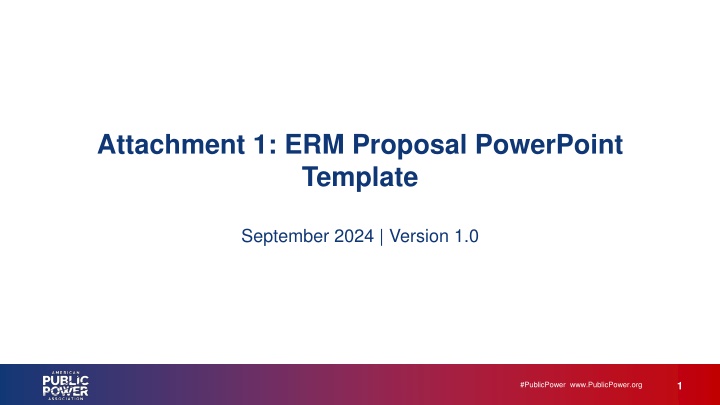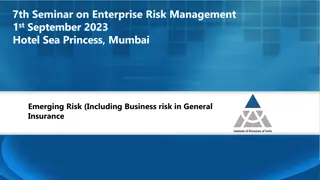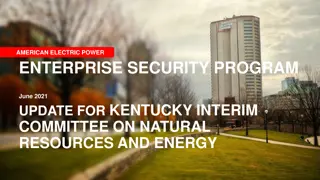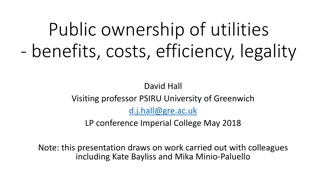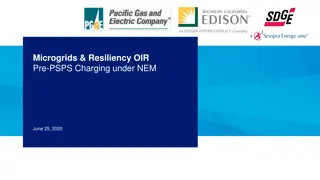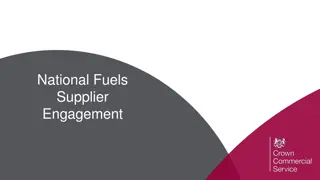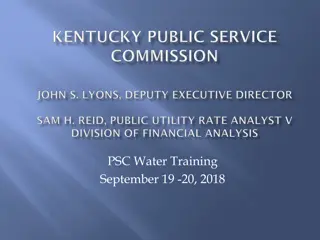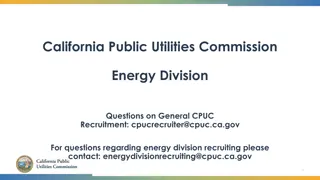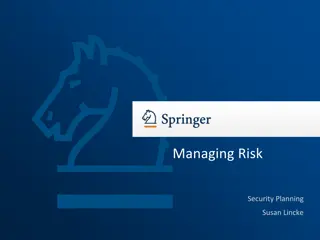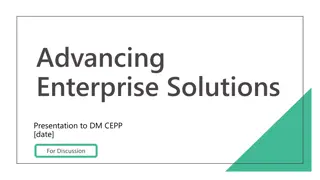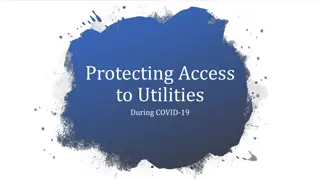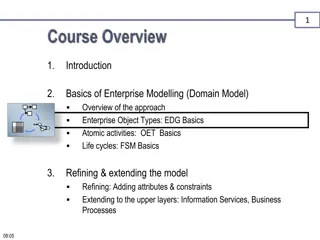Enterprise Risk Management Overview for Public Power Utilities
Essentials of Enterprise Risk Management (ERM) tailored for public power utilities. Learn about the strategic advantages, governance structures, and risk types encountered. Gain insights on developing an effective ERM program to enhance performance and mitigate potential risks effectively."
Download Presentation

Please find below an Image/Link to download the presentation.
The content on the website is provided AS IS for your information and personal use only. It may not be sold, licensed, or shared on other websites without obtaining consent from the author.If you encounter any issues during the download, it is possible that the publisher has removed the file from their server.
You are allowed to download the files provided on this website for personal or commercial use, subject to the condition that they are used lawfully. All files are the property of their respective owners.
The content on the website is provided AS IS for your information and personal use only. It may not be sold, licensed, or shared on other websites without obtaining consent from the author.
E N D
Presentation Transcript
Attachment 1: ERM Proposal PowerPoint Template September 2024 | Version 1.0 1 #PublicPower www.PublicPower.org
Table of Contents Topic Page reference Break the ice Risk 101 Enterprise risk management (ERM) overview What is ERM? Why should [insert utility name] care? Strategic advantage through effective ERM Proposed governance for [insert utility name] s risk management structure Typical ERM lifecycle Phased approach for [utility name] Next steps Proposed ERM Program development plan X X X X X X 2 #PublicPower www.PublicPower.org
Break the ice Think about what risk means to the public power industry Potential Rewards High returns through optimized operations and investments in infrastructure. Invest in the stock market Potential reward: high returns Potential Risks Market Volatility Similar to the stock market, energy markets can be unpredictable. Loss of Capital Poor investments or operational failures can lead to significant financial losses. Potential risk: loss of invested capital Potential risk: market volatility 3 #PublicPower www.PublicPower.org
Understanding the Risk Equation 4 #PublicPower www.PublicPower.org
Break the ice Risk vs Threat While individuals face risks in their personal decisions, utilities encounter risks on a much larger scale, affecting their stakeholders and the market at large. Risk to public power utilities can involve scenarios that lead to financial loss, reputational damage, or operational disruption. Types of risks that utilities commonly encounter: Risk Threat Potential for loss or impact on objectives External factor that could cause harm Definition is Uncertainty about outcomes Specific sources of danger Focuses on Compliance Risk Strategic Risk Power outage from equipment failure Cyber attack on operational systems Example Operational Risk Financial Risk Uncertainty Specific harm Nature is Can be internal or external Cybersecurity Risk Reputational Risk Typically external Origin is It is managed by Geopolitical Risk Environmental Risk Anticipate and prepare Identify and address Human Resource Risk Supply Chain Risk 5 #PublicPower www.PublicPower.org
Enterprise Risk Management What is ERM? Enterprise Risk Management (ERM) is a structured approach used by an organization's leadership to plan strategies and operations with potential risks in mind. Senior management identifies and manages these risks within their risk tolerance, helping ensure the organization meets its goals. Positive Risks that offer opportunities for growth and competitive advantage Outside External factors offering positive / negative effects, beyond organization s direct control Negative Material risks that offer only negative impacts ERM helps organizations use smart insights and a results-focused approach to improve risk management. It integrates with daily business activities and important decisions, enhancing performance and creating more value. Risk Definition ERM Strategic alignment Revenue growth Stakeholder perception and reputation Operational excellence Operating margin Asset efficiency Employee satisfaction Value 6 #PublicPower www.PublicPower.org
Why should [insert utility name] care? Strategic advantage through effective ERM As the public power utility sector navigates the complexities of regulatory changes, environmental concerns, and evolving consumer expectations, the importance of an enhanced risk management framework cannot be overstated. Operational / Financial preparedness Prepares utilities for swift recovery leading to fewer service interruptions and more stable pricing for customers. [Insert utility name] Community confidence Strengthens community trust by ensuring consistent service, which leads to higher customer satisfaction. E Please populate this box with relevant information specific to your utility (see SUGGESTION in the note section) ERM M Strategic risk intelligence Informs leaders about potential risks enabling proactive measures to protect service quality and customer satisfaction. Regulatory vigilance Keeps utilities ahead of the curve with regulations, avoiding fines, and enabling smoother operations through compliance. From reactive to proactive risk management 7 #PublicPower www.PublicPower.org
Proposed Governance for [insert utility name]s Risk Management Structure utility s senior leadership and business units. For [utility name], the recommendation is to form a risk management committee composed of representatives from the [This is a collaborative decision that the governing board and senior leadership should agree on as the outcome of this meeting. The structure will look different for each utility as every utility has different leadership structure. Tailor this according to the utility s leadership structure.] Governing Board Board, City Council, Municipal Council, etc. Chief Senior Leadership CEO or General Manager Chief Operating Officer Chief Administrative Officer/ Chief HR Officer Chief Financial Officer Technology Officer Business Units Human Resources Department Customer Service Department Security and Safety Department Accounting and Payroll Department Transmission or Distribution Department Information Technology Department Purchasing Department Operations Department 8 #PublicPower www.PublicPower.org
Typical ERM Lifecycle Phased approach for [utility name] Phased approach to enhance ERM capabilities Below is a sample representation of a typical ERM lifecycle. The six steps are also color- coded to tie with the three phases [utility name] will pursue in enhancing its ERM capabilities. Phase I Identify and agree on risks to the achievement of strategic goals and objectives of the utility Program stand up (obtain leadership buy in and ERM team set up, etc.) Leadership buy-in, ERM team set-up, risk identification Identify Phase II Enterprise Risk Management Process Report on risk status by establishing cadence and framework for reporting to senior leadership Report Agree on rating criteria and risk tolerance levels and limits. Assess risks against criteria Assess Risk rating criteria & scoring, assessment workshop, scoring risks, risk prioritization, evaluating mitigation strategies, identifying residual risk score Monitor Response Phase III Identify and document risk responses to mitigate risks to within acceptable risk tolerance and limits. Monitor and measure progress of risk responses on a regular basis to identify change from the performance level required or expected KRI design and framework set-up, monitoring of top risks, communication & reporting to leaders Identify residual risk exposure based on mitigations and develop treatment plans. 9 #PublicPower www.PublicPower.org
Next Steps Proposed ERM program development plan Q1 202X Q3 Q4 202X ERM Phase I and II Execution Q2 202X Q1 202X Set Up Governance Structure Project Planning ERM Phase III Execution Create a project plan with key milestones and timelines, including budget and resource requirements. Obtain approval of project plan from senior leadership. Develop a communications plan and inform stakeholders of newly established risk management efforts. Identify and appoint a risk management project lead. Identify and define the risk management team members, roles, and responsibilities. Formalize roles and responsibilities in a risk management project charter. Develop and obtain approval on templates and risk criteria. Conduct ERM 101 training sessions for stakeholders. Execute Phase I and II activities. Develop draft and final risk register. Establish a schedule for regular progress reporting on risk mitigations. Set up monitoring mechanisms for tracking the effectiveness of risk responses. Implement a feedback loop to refine the ERM process based on monitoring outcomes. 10 #PublicPower www.PublicPower.org 10
